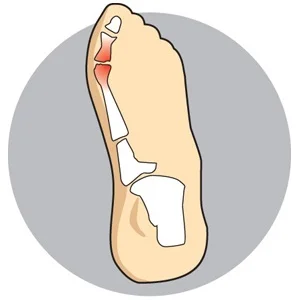Sesamoiditis
Sesamoiditis is a common ailment that affects the forefoot, typically in young people who engage in physical activity like running or dancing.
The term is a general description for any irritation of the sesamoid bones, which are tiny bones within the tendons that run to the big toe. Like the kneecap, the sesamoids function as a pulley, increasing the leverage of the tendons controlling the toe. Every time you push off against the toe the sesamoids are involved, and eventually they can become irritated, even fractured. The tendons around the bones can become inflamed as well.
Causes
Sesamoiditis typically can be distinguished from other forefoot conditions by its gradual onset. The pain usually begins as a mild ache and increases gradually as the aggravating activity is continued. It may build to an intense throbbing. In most cases there is little or no bruising or redness. One of the major causes of sesamoiditis is increased activity. You’ve probably stepped up your activity level lately, which has forced you to put more pressure on the balls of your feet. Speedwork, hillwork, or even increased mileage can cause this. If you have a bony foot, you simply may not have enough fat on your foot to protect your tender sesamoids. Also, if you have a high arched foot, you will naturally run on the balls-of-your-feet, adding even more pressure.
Solutions
Treatment for sesamoiditis is almost always non invasive. Minor cases call for a strict period of rest, along with the use of a modified shoe or a shoe pad to reduce pressure on the affected area. This may be accomplished by placing a metatarsal pad away from the joint so that it redistributes the pressure of weight bearing to other parts of the forefoot. In addition, the big toe may be bound with tape or athletic strapping to immobilize the joint as much as possible and allow for healing to occur. It is recommended to decrease or stop activity for awhile. This will give your sesamoids time to heal. You should apply ice to the area for 10 to 15 minutes after exercise, or after any activity that aggravates the area. As with icing, anti-inflammatory medication will help the swelling go down so healing can begin. While the injury is healing, women should wear flat shoes on a daily basis.
Suffering from this condition?
See one of our podiatrists today.

